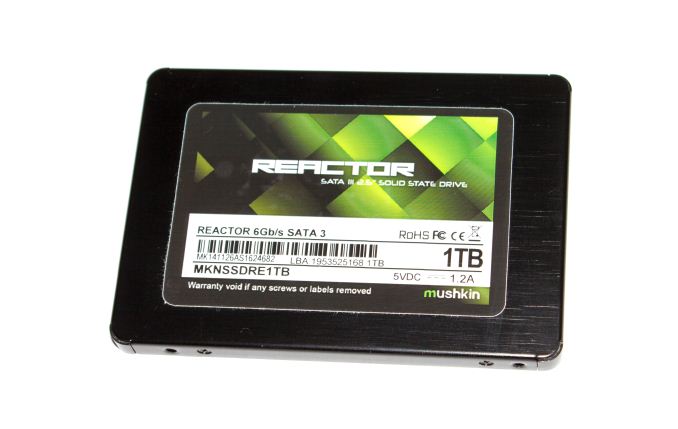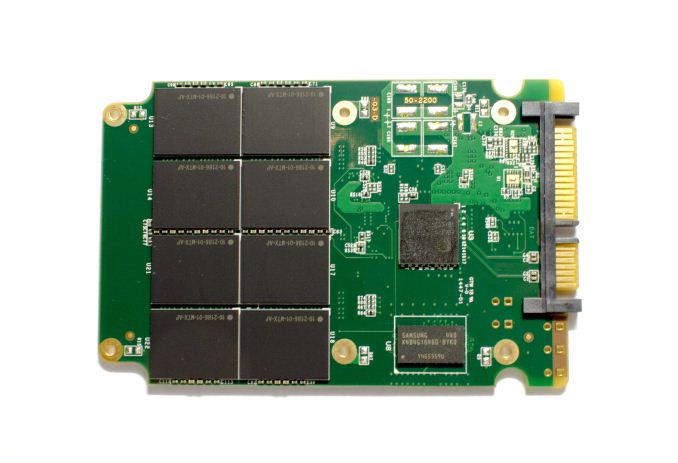Mushkin Reactor 1TB SSD Review
by Kristian Vättö on February 9, 2015 11:32 AM EST- Posted in
- Storage
- SSDs
- Mushkin
- Silicon Motion
- SM2246EN
- Reactor
- Micron 16nm

Silicon Motion has practically become the new SandForce. Almost every tier three manufacturer (i.e. one with no controller/firmware IP or NAND fab) has released an SM2246EN based drive in the past ten months and recently Silicon Motion scored two major tier one partners (namely Micron/Crucial and SanDisk) as well. To be honest, this hasn't come as a surprise because the SM2246EN is a really solid controller with good performance and more importantly it's been mostly issue free (which is something that cannot be said about SandForce).
Mushkin's Reactor combines the SM2246EN with Micron's latest 128Gbit 16nm MLC NAND, and this is actually the first time I've encountered a non-Micron/Crucial SSD with Micron's 16nm NAND. That really emphasizes the benefit NAND manufacturers have because Micron has been using 16nm NAND in its own SSDs for over six months now, but the company hasn't begun shipping it to others in volume until now. I suspect the volumes are still fairly low because the Reactor only comes in 1TB capacity, which is still fairly expensive and thus limits the demand to a level that is easier to manage compared to the more popular 256GB and 512GB models. I was told that 256GB and 512GB models may follow later, but as of now Mushkin will only be offering the Reactor in 1TB.
| Mushkin Reactor Specifications | |
| Capacity | 1TB |
| Controller | Silicon Motion SM2246EN |
| NAND | Micron 128Gbit 16nm MLC |
| Sequential Read | 560MB/s |
| Sequential Write | 460MB/s |
| 4KB Random Read | 74K IOPS |
| 4KB Random Write | 76K IOPS |
| Encryption | N/A |
| Endurance | 144TB |
| Warranty | Three years |
In terms of features the Reactor is a fairly typical value drive without any special features. Neither hardware accelerated encryption nor DevSleep is supported, although the Reactor does support slumber power states for low idle power consumption. Endurance is a respectable 144TB, which translates to 131GB of writes per day for three years.
Moreover, the retail package doesn't include anything in addition to the drive itself and Mushkin offers no software/toolbox for its SSDs.
There are sixteen NAND packages on the PCB with eight on each side. Since we are dealing with a 128Gbit (16GB) die, that translates to four dies per package. Mushkin actually does the packaging in-house (i.e. buys NAND in wafers and then does the binning and packaging), which is why the packages lack the typical Micron logo and labels.
Test Systems
For AnandTech Storage Benches, performance consistency, random and sequential performance, performance vs. transfer size, and load power consumption we use the following system:
| CPU | Intel Core i5-2500K running at 3.3GHz (Turbo & EIST enabled) |
| Motherboard | ASRock Z68 Pro3 |
| Chipset | Intel Z68 |
| Chipset Drivers | Intel 9.1.1.1015 + Intel RST 10.2 |
| Memory | G.Skill RipjawsX DDR3-1600 4 x 8GB (9-9-9-24) |
| Video Card | Palit GeForce GTX 770 JetStream 2GB GDDR5 (1150MHz core clock; 3505MHz GDDR5 effective) |
| Video Drivers | NVIDIA GeForce 332.21 WHQL |
| Desktop Resolution | 1920 x 1080 |
| OS | Windows 7 x64 |
Thanks to G.Skill for the RipjawsX 32GB DDR3 DRAM kit
For slumber power testing we used a different system:
| CPU | Intel Core i7-4770K running at 3.3GHz (Turbo & EIST enabled, C-states disabled) |
| Motherboard | ASUS Z87 Deluxe (BIOS 1707) |
| Chipset | Intel Z87 |
| Chipset Drivers | Intel 9.4.0.1026 + Intel RST 12.9 |
| Memory | Corsair Vengeance DDR3-1866 2x8GB (9-10-9-27 2T) |
| Graphics | Intel HD Graphics 4600 |
| Graphics Drivers | 15.33.8.64.3345 |
| Desktop Resolution | 1920 x 1080 |
| OS | Windows 7 x64 |
- Thanks to Intel for the Core i7-4770K CPU
- Thanks to ASUS for the Z87 Deluxe motherboard
- Thanks to Corsair for the Vengeance 16GB DDR3-1866 DRAM kit, RM750 power supply, Hydro H60 CPU cooler and Carbide 330R case











69 Comments
View All Comments
Shadowmaster625 - Friday, February 13, 2015 - link
That's because SSDs are old and antiquated. NAND should be right on the DIMMs with DRAM, sharing the same bus, the same memory controller, as much of the same hardware as possbile. It should have started 3 years ago and by now we should have had 4GB DRAM + 64GB NAND DIMMs for $120 a pair and 8GB + 128GB for $200 a pair.akrobet - Monday, February 9, 2015 - link
What is holding back the adoption of NVMe M.2 drives?AnnihilatorX - Monday, February 9, 2015 - link
I think: Lack of Chipset support, require most recent OSes, lack of boot support, competing standards -> general consumer confusion (SATA Express vs M.2), Rarity of motherboards with M.2, cost.There is not one specific reason holding back, but I guess you can just say with all new tech adoption will be low at first, and this would be the explanation.
galta - Monday, February 9, 2015 - link
I boot with my Plextor M.2dgingeri - Monday, February 9, 2015 - link
The M6e doesn't do NVMe. It's AHCI, which restricts performance somewhat.BillyONeal - Monday, February 9, 2015 - link
The article says that you don't think the 850 EVO is worth 60 dollars more; but in the list they're the same price. Typo?Kristian Vättö - Monday, February 9, 2015 - link
Read the full sentence."That said, if the prices go up to $450 again, the Reactor will become a better choice because despite the performance and features I don't find the 850 EVO to be worth $60 more."
Kristian Vättö - Monday, February 9, 2015 - link
I also edited it to be more clear now.BillyONeal - Monday, February 9, 2015 - link
Makes sense. Thanks!Andy Chow - Monday, February 9, 2015 - link
A 1TB drive with 144 TB endurance? No thanks!